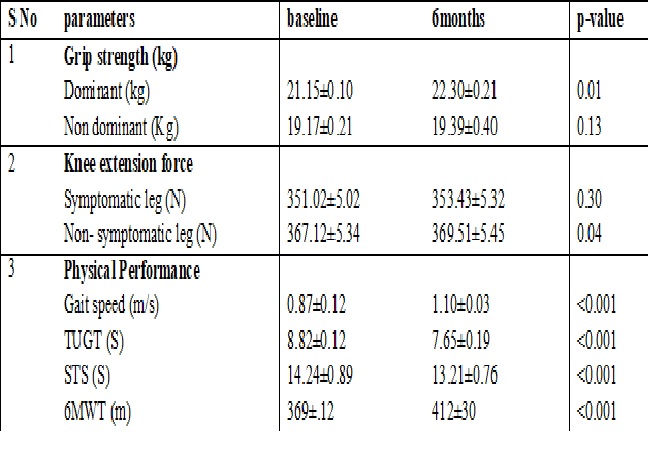A study of effect of Vitamin D supplementation inOsteoarthritis patients
Abstract
Introduction: Osteoarthritis (OA) is the common cause of musculoskeletal disability and pain. Osteoarthritis (OA) is a chronic disease characterized by a loss of articular cartilage and changes of the subchondral bone. Lower levels of vitamin D were associated with greater knee pain, poor quadriceps function with poor physical function. Several studies have documented that vitamin D supplementation increases muscle strength, improve physical performance, and decreases risk of falls among older people with low level of serum vitamin D.
Materials &Methods:This present study was conducted at the outpatient clinic of the Department ofOrthopedics at Maheswara Medical college & Hospital, Sangareddy during a February–December 2017 study period.The inclusion criteria were that the participants had symptomatic knee OA and low vitamin D status (25(OH)D < 30 ng/mL).
Results:Data were analyzed using SPSS Statistics version 22 (SPSS, Inc., Chicago, IL, USA). Comparisonof baseline vs. post-vitamin Dsupplementation data was performed by paired t-test. One-wayrepeated-measurement ANOVA was used to test the time differences in muscle strength and physicalperformance. A p-value less than 0.05 for differences and the values were considered to be statistically significant.Dominant grip strength (p = 0.01) and overall physical performance, such as gait speed (p < 0.001),TUGT (p < 0.001), STS (p < 0.001), and 6MWT (p < 0.001), significantly improved after vitamin.
Conclusion:Nevertheless, vitamin D supplementation is a safe and inexpensive way to improve muscle strength and physical function in this population. Based on these findings, we recommend vitamin D supplementation in knee OA patients that have poor physical function.
Downloads
References
2. Bischoff HA, Stähelin HB, Dick W et al. Effects of vitamin D and calcium supplementation on falls: a randomized controlled trial. DOI:10.1359/jbmr.2003.18.2.343.[pubmed]
3. Cruz-Jentoft AJ, Baeyens JP, Bauer JM, Boirie Y, et al. Sarcopenia: European consensus on definition and diagnosis: Report of the European Working Group on Sarcopenia in Older People. DOI:10.1093/ageing/afq034.[pubmed]
4. Maly MR, Costigan PA, Olney SJ. Determinants of self-report outcome measures in people with knee osteoarthritis. DOI:10.1016/j.apmr.2005.08.110. [pubmed]
5. Mijnarends DM, Meijers JM, Halfens RJ et al. Validity and reliability of tools to measure muscle mass, strength, and physical performance in community-dwelling older people: a systematic review. DOI:10.1016/j.jamda.2012.10.009.[pubmed]
6. Zhu K, Austin N, Devine Aet al. A randomized controlled trial of the effects of vitamin D on muscle strength and mobility in olderwomen with vitamin D insufficiency. DOI:10.1111/j.1532-5415.2010.03142.x.[pubmed]
7. Lagari V, Gómez-Marín O, Levis S. The role of vitamin D in improving physical performance in the elderly. DOI:10.1002/jbmr.1949.[pubmed]
8. Sato Y, Iwamoto J, Kanoko T, Satoh K. Low-dose vitamin D prevents muscular atrophy and reduces falls and hip fractures in womenafter stroke: a randomized controlled trial. DOI:10.1159/000087203.
9. Ceglia L, Niramitmahapanya S, da Silva Morais Met al. A randomized study on the effect of vitamin D₃ supplementation on skeletal muscle morphology and vitamin D receptor concentration in older women. DOI:10.1210/jc.2013-2820
10. Kenny AM, Biskup B, Robbins B et al. Effects of vitamin D supplementation on strength, physical function, and health perception in older, community-dwelling men. J Am Geriatr Soc. 2003 Dec;51(12):1762-7.[pubmed]



 OAI - Open Archives Initiative
OAI - Open Archives Initiative


















 Therapoid
Therapoid

